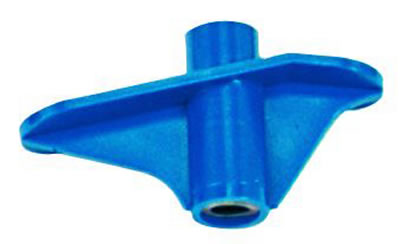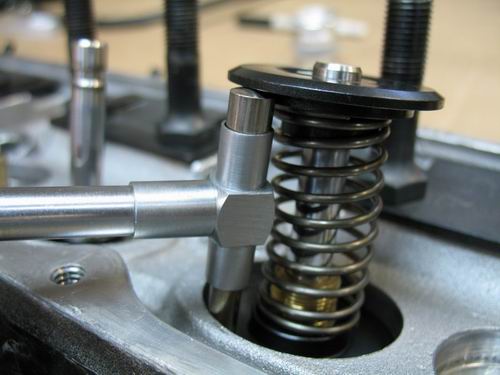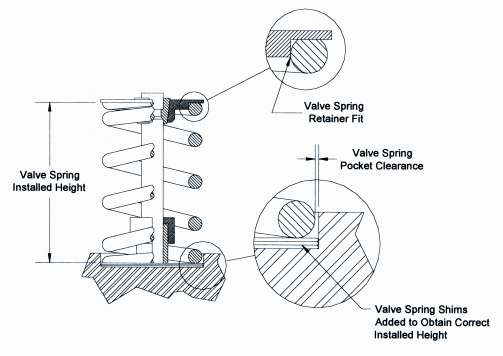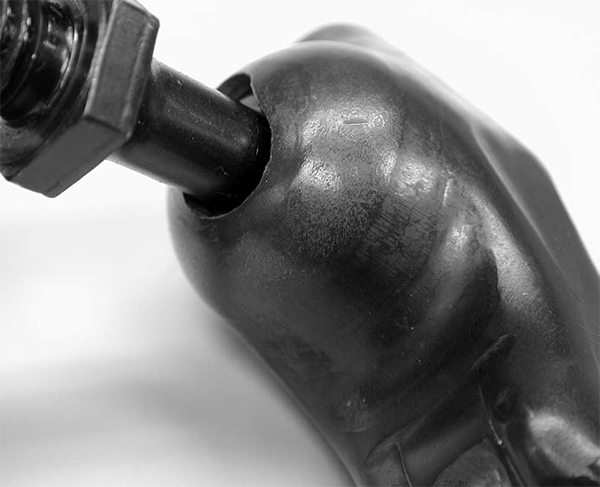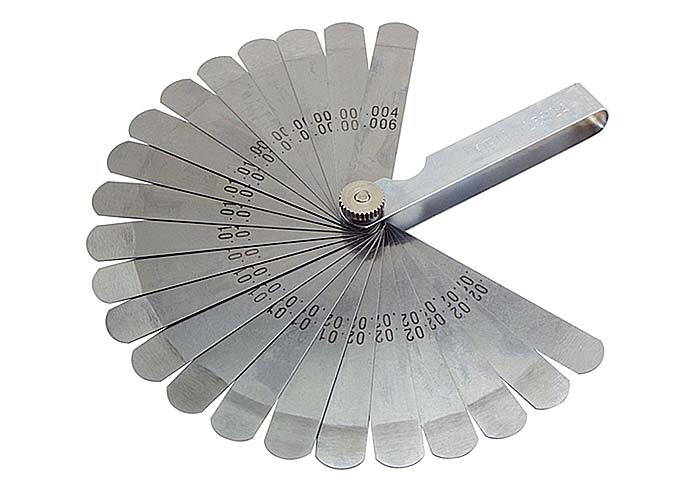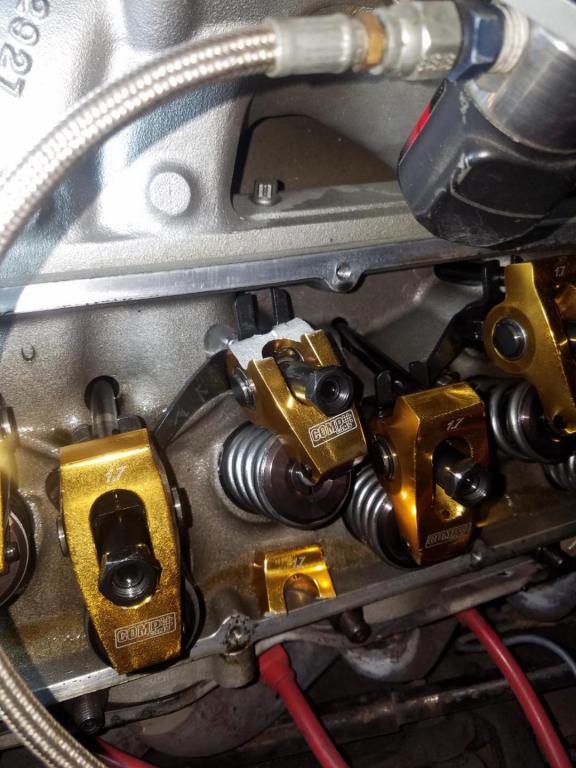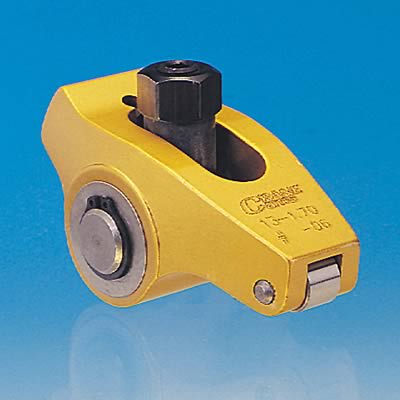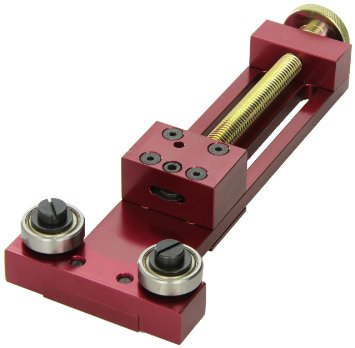KM said:Put vortec heads on my L98 and ordered 1417 1.52 Roller Rockers and 7808 Pushrods from CompCams. Installed screw in rocker studs with guide tool before assembly of the engine. Checked valve geometry and the roller left a mark right on the center of the valve like its supposed to.
Oil pressure has always been strong, between 30-50 on the gauge. Assembly lube was used between the lifters and pushrods on installation.
I called Comp and they said they would replace them within 1 year of purchase, thats no problem. I am worried however, replacing them without figuring out what happened tends to yield the same results.
The valve lash was set initially to start the engine. At operating temperature, the rockers were backed off one by one and tightened until no ticking was heard
I used the Comp assembly lube on every rocker before installation.
As I adjusted the valves at operating temp, I observed the oil also. No problem there.
I did not check the rods for straightness, will do that tomorrow and let you know.
The oil may have been dirty, but it happened to every single one of them which leads me to believe its a tolerance problem somewhere.
Cam is 08-502-8 Compcam.
http://www.summitracing.com/parts/cca-0 ... /overview/
Retainer to valve checked on every valve, .561 being the smallest value I received on an intake valve. With 1.52 rockers I get max lift values of .502 Int & .509 Exh
BTW.IF YOUR BUILDING A SBC
http://brodix.com/heads-2/small-block-chevrolet-compatible-heads/ik-series
http://www.jegs.com/i/Brodix/158/1021001/10002/-1
http://garage.grumpysperformance.co...train-clearances-and-problems.528/#post-57678
brodix ph# 1-479-394-1075 (ALWAYS VERIFY PART NUMBERS SEVERAL,
TIMES FROM AT LEAST TWO SOURCES, BEFORE ORDERING PARTS)
the brodix rock stud girdle is part # BR-6435 and LIST price is about $230 you can get it for less if you shop carefully
BE AWARE that the I.K. 200 heads were shipped with BOTH 3/8" and 7/16" rocker studs ,
and the poly locks for the 7/16" rocker studs ONLY fit that rocker stud girdle
obviously you need to verify what your heads have before you order the matching rocker stud girdle
Verifying your engines clearances, and rocker geometry, and use of A rocker stud girdle and high quality roller rockers go a long way towards maintaining valve train durability

I also checked my coil bind values, springs are PAC 1218 Beehives with 7/32 beehive retainers and locks.
https://www.youtube.com/watch?time_continue=15&v=PruJ4FSmhP4
if youve ever wondered why the press in rock studs work loose and pull out of heads,
or why some less expensive rocker studs break, keep in mind the rocker and push rods,
are under hundreds of ft lbs of valve spring pressure and the rocker studs deflect significantly under load,
as the lifter rides up on the cam lobe and the valve spring deflects under load,
its really a miracle more rockers and rocker studs don,t snap off.
and the video, shows clearly why rocker stud girdles add considerable valve train stability
Took them off for inspection and found this.
and thats more closely related to average stress levels, RPM and VALVE SPRING LOAD RATES
any time your occasionally exceeding 6000rpm or getting close too 330 lbs of open valve load rate Id strongly suggest screw in rocker studs
any time your intentionally exceeding 6000rpm and exceeding 350 lbs of open valve spring rate a rocker stud girdle might be a good idea.
and if your regularly exceeding 6500rpm and 400 lbs of open valve spring load rate its use is going to become almost mandatory
http://www.summitracing.com/parts/pro-66950
http://www.summitracing.com/parts/sum-141010
while I generally use stainless 6 or 8 mesh screens theres lots of options that will work just fine, just remember to keep the oil changed regularly or theres some potential for sludge to clog ANY size shrapnel screens
http://www.twpinc.com/twpinc/products/T ... 6T0350W36T
http://www.twpinc.com/twpinc/products/T ... 8S0280W36T

http://www.summitracing.com/parts/mor-25026?seid=srese1&gclid=COOf2IODscgCFZKAaQodHWoF1Q
it should not take a great deal of imagination to see that a broken rocker, lifter or push-rod could dump metalic debris into an oil drain back port that wold rapidly result in increased internal engine damage as a result.

IVE typically used these magnets in an engine, one in the rear oil drain on each cylinder head, one near each lifter gallery drain and 4 in the oil pan sump
proper magnets trap metallic debris
SmCo Samarium Cobalt Disc Magnets
http://www.magnet4less.com/
many magnets lose their magnetic pull if heated to 200F
these below won,t
proper magnets trap metallic debris
SmCo Samarium Cobalt Disc Magnets
http://www.magnet4less.com/

http://www.magnet4less.com/product_...ucts_id=254&osCsid=ckl4nevgdrmireotnegg7jcf36
http://www.magnet4sale.com/smco-magnets-dia-1x3-8-samarium-cobalt-magnets-608-f-temperature/
Samarium Cobalt MAGNETS HELP
http://www.magnet4sale.com/smco-disk-magnet-dia-1x1-4-samarium-cobalt-magnets-608-f-temperature/
magnets are ceramic and glass hard, don,t try to drill or grind them, as they can shatter




Even with roller valve train there is a break in period where the metals have to "mate". on flat tappet valve trains and non-roller rocker valve trains use of a good moly assembly lube is critical, Break in oils and assembly lubes have high pressure additives to help protect these new surfaces while this "mating" is taking place. Regular motor oil does not, always have the required additives or enough of them. thus using a good moly based assembly lube on lifters and bearings helps reduce wear , on roller rockers and roller lifter a mix of 50% assembly lube and 50% MARVEL MYSTERY OIL, thins this moly mix viscosity allowing it to penetrate roller bearings far faster
http://garage.grumpysperformance.com/index.php?threads/freeing-up-sticky-hydraulic-lifters.15582/
https://www.youtube.com/watch?v=o5is9BsH5OU
http://engineprofessional.com/articles/EPQ409_58-62.pdf
pre-spraying all bearing and valve train components with a moly based spray, helps embed micro moly lubricants in the metallic surface micro fissures , a good paste lube like cranes assembly lube over the spray surface helps insure a good lubricant surface coating, that is far stronger than just the ZINC and PHOSPHATES in oil




look at the tip of the rocker and push rod , all the wear is in the same sweep direction,across the tip,if the push-rod clearance was too great they would tend to bounce and rotate on contact, the consistent wear tends to indicate the lash clearance or pre-load is too tight or your not getting nearly enough oil flow,on the contact point between the rocker and push rod tips, on that roller lifter cam, and there's not enough oil flow thru the contact wear points , so Id suggest cleaning out any crap that might be inside the push rods and adjusting the valve pre-load so there's oil flowing at idle from the rockers, failure to have consistent oil flow or having the wrong clearances could easily result in rapid wear from the wrong clearances or geometry or lack of oil flow , especially if the push rods bind in the guide plates or cylinder heads guide slots, thus reducing the push rods tendency to move , Id sure inspect the whole length of the push rod and expect to see wear indications where the push rod goes thru the guide plates or head slots
BTW wear like that indicates you have micro metallic crap in the oil (its un-avoidable) if you have MAGNETS they probably trapped and held the vast majority, but you might want to consider changing your oil and filter and checking your oil filter internally, and yes I know your thinking of just replacing the push-rods and reusing the rockers due to cost issues, but if you do it will result in a repeat due to the worn surfaces, so replace both the rockers and push rods and this time verify the clearances and rocker geometry much more carefully and adjust the rockers so they have minimal pre-load.
now theres a small chance you could successfully pollish out the rockers push rod cup area with a dremel tool and the correct size and shape hard grinding stones to a point they could be re-used but Id strongly suggest buying new rockers is the safer route
Ive never had an issue re-using old push rods on new roller rockers with a good dose of moly cam lube on the tips , AS LONG AS the tips looked like they were in decent condition and not obviously worn,after, they passed a close inspection before they were used, OBVIOUSLY THE PICTURES ABOVE ARE PUSH RODS THAT GO IN THE DUMPSTER, most good brand name aluminum or steel roller rockers have pressed in hardened steel push rod seats that are far less likely to wear than the tips of the push rods.


Big Block Chevy, Standard Length Big Block Intake 3/8" / .080" 8.275"
295-7941-8 Big Block Chevy, Standard Length Big Block Exhaust 3/8" / .080" 9.250"
295-7969-8 Big Block Chevy, Standard Big Block +.100" Long Intake 3/8" / .080" 8.375"
295-7979-8 Big Block Chevy, Standard Big Block +.100" Long Exhaust 3/8" / .080" 9.350"
295-7951-8 Big Block Chevy, Standard Length Big Block Tall Deck Intake 3/8" / .080" 8.675"
295-7961-8 Big Block Chevy, Standard Length Big Block Tall Deck Exhaust 3/8" / .080" 9.650"
295-7800 V8 396-454 Retro Fit Pushrod Set, Intake & Exhaust, 1965-Present
3/8" / .080"
3/8" / .080" 7.725 Int.
8.675 Exh
295-7913-16 Small Block Chevy, Standard Length Small Block Chevy 3/8" / .080" 7.800"
295-7984-16 Small Block Chevy, +.100" Long 3/8" / .080" 7.900"
295-7934-16 Big Block Ford, Standard Length Ford `72-'78 429-460 3/8" / .080" 8.550"
295-7951-16 Big Block Ford, Standard Length Ford `69-'71 429-460 3/8" / .080" 8.675"
295-7582-16 Oldsmobile, Std Length 455 5/16" 9.550"

OBVIOUSLY that assumes you have no valve train clearance issues, binding or geometry or lubrication issues, and you set the lash or lifter pre-load on the valve train correctly and use the correct oil, and it certainly would help any engines durability to have provisions for adequate valve train oiling and a bit extra valve train cooling can be helpful on an engine designed for higher rpm use.
heres a really interesting series of pictures taken when a guy was checking the correct push rod length and rocker geometry on a big block chevy, he noticed the dial indicator readings were not consistent, the cause was traced to the push rod guide plates contacting the push rod and binding the push rod making the tip move across the rocker push rod pivot cup. if the engine was run like that with the push rod binding in the guide plate parts failure was certain to occur in a reasonably short time
https://www.hotrod.com/articles/ctrp-0805-valvetrain-dynamics/
http://www.summitracing.com/parts/pro-66830/overview/

https://www.youtube.com/watch?time_continue=5&v=o5is9BsH5OU


https://www.harborfreight.com/multipositional-magnetic-base-with-fine-adjustment-5645.html

https://www.harborfreight.com/catalogsearch/result/index/?dir=asc&order=EAScore,f,EAFeatured+Weight,f,Sale+Rank,f&q=indicator+stand




If your thinking you can swap to the 1.6:1 rockers without checking clearances carefully, ...probably not, your certainly going to need to check and verify clearances , and yeah, youll find a dozen guys that say they did it with zero problems......many could also tell you that in a few months they experienced a cam lobe /lifter or rocker failure as the push rod binding in even only part of the rockers arc, tends to cause excessive wear on the valve train, it might take some time but it will result in component failure over time if parts can,t move freely as designed.


youll want too use a .060 clearance too the push rod to cylinder head slot clearance CHECKED CAREFULLY OVER THE FULL ARC OF THE ROCKER TRAVEL FOR A FULL TWO ENGINE ROTATIONS
if you need a LOUIS TOOL to lengthen the slots in the cylinder head I generally lay a section of plastic wrap in the lifter gallery and be sure to place two magnets on the blocks lifter gallery wall, to hold the thin plastic wrap in place firmly, below the cylinder head while drilling to catch the metalic debris the drill will generally produce, between the plastic sheat and the magnets youll generally catch 100% of the trash the drill generates





btw place a magnet like this under each pushrod slot to catch the drill chips from iron heads

These Proform pushrod slotting tools are designed to elongate the pushrod slot in the cylinder head. They will make room for higher ratio rocker arms. Use these tools with a drill and a 5/16 in. drill bit to elongate the pushrod slot.

http://garage.grumpysperformance.co...o-rockers-and-the-pushrods-rub.198/#post-3033
http://garage.grumpysperformance.co...swap-in-1-6-1-ratio-rockers.10671/#post-46039
http://garage.grumpysperformance.co...e-train-clearances-and-problems.528/#post-664

REMEMBER TO CAREFULLY CHECK THE PUSH ROD TOO CYLINDER HEAD GUIDE SLOT AND CYLINDER HEAD CASTING CLEARANCES,IF THE PUSH ROD BINDS IT MAY CAUSE A LOSS OF OIL FLOW THROUGH THE PUSH ROD, FROM LIFTER TOO ROCKER OR THE LIFTER TO WEAR RAPIDLY
checking all valve train clearance issues in mandatory
notice the adjustable length checking push rod used below and the push rod binding in the guide plates

I can,t even begin to tell you how many times I see guys slap a new cam in an engine and not carefully verify all the rocker geometry and clearances, and it sure does not take a great deal of valve train binding to cause serious problems
A Simple Test for Valvetrain Deflection
Engine building is all about attending to the details. The professionals know that all is not as it seems when it comes to something as simple as valve lift. We had an opportunity to discuss this with Ben Strader, president of EFI University, where he and his staff not only teach engine building and EFI tuning, but also apply what they learn on the dyno.
By
Trend Performance
on
Jun 1, 2018

Engine building is all about attending to the details. The professionals know that all is not as it seems when it comes to something as simple as valve lift. We had an opportunity to discuss this with Ben Strader, president of EFI University, where he and his staff not only teach engine building and EFI tuning, but also apply what they learn on the dyno. Amid a day-long discussion concerning engine building, Strader mentioned that one of the best ways to evaluate the quality of a valvetrain is to rate it based on stiffness.
Valvetrains are subject to essentially two different ways load is applied, generally referred to as static and dynamic. Static load is simply the load you can measure with a spring load tester and then multiplied by the rocker ratio. For example, if we have 500 pounds of spring load at maximum valve lift and a rocker ratio of 1.5:1, the rocker arm, rocker stud, pushrod, and lifter are exposed to a static load of 750 pounds (500 x 1.5 = 750 lbs) of force.

We started this exercise by checking maximum valve lift on the exhaust valve of this 540ci big-block Chevy using a light-duty checking spring. The maximum lift measured 0.744-inch.
The second type is called dynamic load which accounts for the forces applied to the valvetrain while accelerating and decelerating the valve at various engine speeds. These dynamic forces are incredibly high and impart loads much greater than what we can measure statically since these components are accelerating at incredible speeds even at engine speeds of 6,000 to 7,000 rpm. Of course, the load increases with each jump in engine speed.
One way we can verify or measure the effective stiffness of the valvetrain is to perform a stiffness test. The usefulness of this test is in its simplicity. The process involves comparing maximum valve lift with a checking spring against the lift created using the actual valve spring. The average enthusiasts might consider this to be a waste of effort because the numbers should be the same. But all it takes is a simple test like this on a performance engine to realize that there’s some bending happening in the valvetrain.
Let’s use a real-world example to show how this works. We started with a big-block Chevy by measuring maximum valve lift on the exhaust side by using a checking spring instead of the actual valve spring.
The test used a Crane 1.7:1 aluminum roller rocker, an 0.080-inch wall thickness, 3/8-inch diameter Trend pushrod, and a mechanical roller lifter. Using the checking spring, we measured maximum lift on the exhaust side at 0.746-inch. We then switched to a cylinder already loaded with the intended valve spring at its proper installed height. This spring checked on our Longacre load tester with 235 pounds on the seat.
We then repeated the lift test except with the dual spring in place which revealed a peak lift of 0.710-inch. We ran through this test three times to ensure this number was correct. This meant that by adding spring pressure, this typical big-block rocker stud combination had managed to lose 0.036-inch of valve lift. Strader offered a list of potential sources where this bending could originate that we’ve included.

Next, we checked the max lift on an adjacent valve with the actual valve spring using the same lifter, pushrod, and rocker arm. We were surprised to find that with 600 pounds of open load, the max lift dropped to 0.710-inch. This resulted in a deflection of 0.034-inch.
Our first thought was to test for pushrod deflection. We measured the valve spring load at 0.710-inch of valve lift and came up with 610 pounds. We will assume a 1.7:1 rocker ratio. We can also assume the actual ratio changes based on the position of the rocker over the valve at max lift. The rocker ratio multiplies the load that the pushrod sees – which means the load on the pushrod is 610 x 1.7 = 1,037 pounds. This is the static load and does not take into account the acceleration rates imposed on the system that could easily achieve g-loads of 250 to 300 g’s. But that’s a story for another time.
While it’s likely that the pushrod will deflect slightly with this much load because it is not perfectly vertical, this may not the only source of deflection. Because this is a stud-mounted rocker arm system, it’s entirely possible that even with high quality 7/16-inch rocker studs that they could also deflect. This is where a stud girdle would be of further benefit. The ideal solution would be the addition of a quality shaft rocker system such as one from Jesel or T&D but by this time, unless your combination calls for spring loads that approach 1,000 pounds open, the return on the investment might not be strong enough.
The rocker arm is another place where the system could be deflecting. Aluminum is the most often-used material for rockers in an effort to reduce weight, but this comes at a price. While lighter, aluminum is far less rigid when compared to steel. However, in this case, we tested both aluminum and steel versions and recorded no difference in maximum lift. Of much greater concern is the effect of pushrod length on the entire lift curve. We did not perform a refined pushrod length test on this engine to determine the ideal length. If pushrod length is not ideal, this will affect the overall rocker ratio by changing the distance the rocker travels across the tip of the valve. This might be cause for a separate story on the effect of pushrod length on lift.
All of this effort to reduce deflection focuses mainly on improving the overall stiffness of the valvetrain. Strader says that he learned a simple way to calculate the stiffness that can then be used to evaluate different valvetrains from a noted cam designer. His source recommended simply dividing the peak valve spring load by the amount of the deflection. In our case, this was a spring load of 610 pounds divided by the deflection of 0.036-inch. This generates a stiffness rating of 16,944 pounds-per-inch. Note this is a load rating, not a pressure rating so the load is expressed in pounds-per-inch.
Strader’s source also created a rating system based on this load number and considers 20,000 pounds/inch and above to be acceptable. If your system generates a rating of 25,000 pounds/inch or more –consider your efforts justly rewarded.
As you can see, this big-block is fairly close to that 20,000 lbs/in threshold stiffness number. The variables are both the spring load and the amount of deflection. Achieving a higher number could be attained by either reducing the spring load – which most engine builders don’t prefer – or to increase the stiffness by reducing the deflection. All this information also only relates to static testing and only the relative stiffness has an impact on the dynamic part of this equation. In reference to that, reducing the weight with a tool steel or titanium retainer, for example, is one place where this has little impact on stiffness yet would drastically reduce the dynamic load the spring is forced to deal with at high rpm.
This brings us back to our original test. We decided this engine’s low-hanging fruit might be the 3/8-inch, 0.080-inch wall thickness pushrods. So we ordered a set of Trend pushrods in the same 3/8-inch diameter and length but with a thicker, 0.135-inch wall that is rated to be 37 percent stiffer.

We were using a typical 3/8-inch, 0.080-inch wall thickness pushrod for this test. For comparison, we decided to do a simple strength upgrade by moving to a Trend 3/8-inch pushrod with a stronger, 0.135-inch wall thickness. Externally, the pushrods appear the same although the stronger pushrod is slightly heavier. We measured an 8.600, 0.135-inch wall thickness pushrod at 109 grams vs. an 0.080-inch wall pushrod of the same length that weighs 82 grams. That’s a 27 gram difference that equals a 33 percentage weight increase.
Plugging the thicker-wall pushrod into our 540ci test engine immediately improved the valve lift under actual spring load from 0.710 to 0.718-inch. That’s an instant valve lift improvement of 0.008-inch. We were hoping for more, but considering the ease with which this gain was achieved, it’s hard to argue the improvement. This also required recalculating the stiffness rating. There was only a slight change in the spring load, with the 0.718-inch lift working against 619 pounds. Calculating the rating then produced a stiffness rating of 22,107 lbs/in which is a significant improvement over the original 16,944 lbs/in number. Doing the math, that’s a 30 percent improvement in valvetrain stiffness just by changing to a slightly thicker wall pushrod! That’s the most amazing part of what would appear to be an otherwise minor change in deflection.
To take this evaluation one step further, we tested a 7/16- to 3/8-inch fully tapered pushrod in that same exhaust location using the same length pushrod. Running through the lift curve once more, we saw only a very slight improvement of 0.002-inch of valve lift over the 0.135-inch wall thickness pushrod. So in this case, there was little to be gained. In a system with a maximum spring load of over 800 lbs/in, this is where the larger tapered pushrod would see more improvement.

Adding the new Trend 0.135-inch wall pushrod improved maximum valve lift by reducing pushrod deflection. Just adding the pushrods improved valve lift by 0.008-inch. That’s a 25 percent reduction in deflection! You won’t find an easier way to improve valvetrain stability.
There’s much more to this story but there’s enough here to keep you busy checking valvetrain deflection on your own engine. We’d like to thank Ben Strader and EFI University for his willingness to share this information. This is just one small part of what his company offers in its Competition Engine Development (CED) course, so if this little snippet of information intrigues you, there’s much more to learn. You can find details on the CED course at efi101.com.
Sources of Valvetrain Deflection
- Rocker Stud Deflection
- Pushrod Deflection
- Rocker arm Deflection
- Rocker Travel Across Valve Tip
- Length of Pushrod
- Lifter Bore Clearance
- Pushrod Angle
- Cam Core Diameter
https://www.ebay.com/i/402584062207...1291&msclkid=d17e7155654a1a20769a115a09f43c68
if the lifter base is well worn you can bet the farm the cam lobe is most likely also worn, and you'll need a lifter removal tool to pull the damage lifters up out through the blocks lifter bores
https://www.ebay.com/i/402584062207...1291&msclkid=d17e7155654a1a20769a115a09f43c68

if the lifters are very badly damaged, it may be best to remove the push rods , use strong magnets to hold the lifters in place and remove the cam, then slide a section of pvc pipe with the upper half removed and let each individual lifter fall into the pipe and be removed one at a time and be removed rather than risk damaging the lifter bore walls, dragging the damaged lifters out through the blocks lifter bores

https://www.amazon.com/Player-Supreme-Golf-Tubes-Dividers/dp/B007BCW7E2/ref=sr_1_5?adgrpid=1343603775697452&dchild=1&hvadid=83975307164276&hvbmt=bp&hvdev=c&hvlocphy=45536&hvnetw=o&hvqmt=p&hvtargid=kwd-83975585067557:loc-190&hydadcr=6896_10422387&keywords=golf+club+tubes+for+golf+bag&qid=1614444214&sr=8-5&tag=mh0b-20
the thin plastic golf club bag tube organizers are almost ideal,
they are available in 1.25", 1.5" and 2" diameters
as they are easy to modify for retrieving lifters from the cam journals, as the golf bag organizer tubs are stiff but east to modify and cut if you need to retrieve lifters by dropping them into the cam journal area
READ THRU THE LINKS
http://www.airflowresearch.com/car-craft-nov-2014-pushrods.php
http://garage.grumpysperformance.co...g-block-pushrod-guide-plates.4596/#post-52034
http://www.hotrod.com/how-to/engine/ctr ... ubricants/
never use both push rod guides and self aligning rockers
youll be far ahead if you carefully read the linked and sub-linked info
some time spent reading related links about your potential valve train issues could prevent lots of potential problems
http://garage.grumpysperformance.co...-pushrods-and-check-info-you-might-need.5931/
http://garage.grumpysperformance.co...rect-custom-length-pushrods.14241/#post-72353
http://garage.grumpysperformance.co...-rockers-and-the-pushrods-rub.198/#post-46839
http://garage.grumpysperformance.com/index.php?threads/press-in-vs-threaded-rocker-studs.2746/
http://garage.grumpysperformance.co...s-tool-swapping-to-1-6-1-ratio-rockers.14761/
http://garage.grumpysperformance.co...rdering-correct-custom-length-pushrods.14241/
http://garage.grumpysperformance.co...ange-in-valve-spring-iinstalled-height.12791/
http://garage.grumpysperformance.co...1-6-1-ratio-rockers-and-the-pushrods-rub.198/
http://garage.grumpysperformance.com/index.php?threads/wrong-rocker.13987/#post-71250
http://garage.grumpysperformance.co...rect-custom-length-pushrods.14241/#post-72346
http://garage.grumpysperformance.co...train-clearances-and-problems.528/#post-57678
http://garage.grumpysperformance.co...engine-and-bent-two-pushrods.4712/#post-56192
http://garage.grumpysperformance.com/index.php?threads/rocker-push-rod-wear-issues.9815/#post-54088
http://garage.grumpysperformance.co...-in-vs-threaded-rocker-studs.2746/#post-43539
http://garage.grumpysperformance.co...-rockers-and-the-pushrods-rub.198/#post-46839
http://garage.grumpysperformance.co...nd-check-info-you-might-need.5931/#post-18267
http://garage.grumpysperformance.co...all-block-chevy-guide-plates.2839/#post-12739
Last edited by a moderator:



